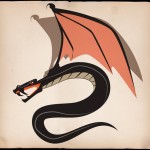(Wonders and Marvels contributor)
Egyptian tales of flying snakes captured the curiosity of the Greek historian Herodotus (ca 460 BC). These winged drakontes were said to live under frankincense (Boswellia) trees in the Arabian Desert. To gather the incense, the Arabians burned styrax (resin of the Liquidambar tree) because the smoke drove the winged snakes away. Herodotus described the flying reptiles as small with variegated markings, shaped like a water snake but with wing like membranes, like bat wings.
The Arabs told Herodotus that these creatures would be a plague upon the earth except for two reasons. In the first place, the violence of their reproductive life ensures that their population remains small. Not only does the female kill the male during mating by “biting clean through his neck,” but the females give birth to live young instead of laying eggs like other serpents—and these young are so vicious that “they are born by eating their way out of the womb thus killing their mother.” The other reason was that when winged snakes fly east from the desert toward Egypt in spring, they travel through a mountain pass where “ibis birds” gobble them up. “Entirely jet black with legs like a crane and a very hooked beak,” these birds, adds Herodotus helpfully, “are the size of a Greek krex” (if only we knew what a krex was!)
“I went to try to get more information about the flying snakes,” says Herodotus. In the vicinity of “Boutos” in Arabia he was shown “narrow mountain pass leading to a broad plain which joins the plain of Egypt.” There he marveled at the “heaps of skeletons and spines in incalculable numbers; some skeletons were large, others smaller, and others smaller still.”
These passages are among the most cryptic in Herodotus (2.75, 3.107-8). Classicists, natural historians, and cryptozoologists have long puzzled over what Herodotus saw and where he saw it. Were there any germs of truth in his account of the Egyptian lore?
At least we can identify Boutos, an ancient city on the eastern Nile Delta at the edge of the Arabian Desert (Sinai Peninsula) and make a good guess at the bird. In antiquity, the black Glossy Ibis (Plegadis falcinellus) frequented the brackish Bitter Lakes region of dry salt valleys between Egypt and Sinai (now the Suez Canal). A more likely candidate would be an extinct relative of the now nearly extinct Waldrapp (Geronticus) northern bald ibis. These migratory black desert ibises were once widespread across North Africa and the Middle East, breeding on cliffs in arid habitats rather than wetlands like their cousins. Ibises fed on insects and reptiles.
What about the winged snakes? Was the lore based on legendary hordes of large flying insects, perhaps locusts, preyed on by huge flocks of birds? Was there once a population of “parachuting” lizards or “gliding” snakes in the Sinai? (Draco volans and Chrysopelia, respectively, are now only found in southeast Asia). Note that Herodotus was never shown live specimens, only heaps of jumbled bones of different sizes. Could the Egyptian tales have arisen to explain mysterious fossil deposits of spinosaurid dinosaurs (with a membrane “sail”), or a large mixed deposit of fossil birds and reptiles eroding out of a salt valley now obliterated by the Suez Canal? The true identity of the winged snakes of ancient Arabia remain a tantalizing unsolved enigma.
About the author: Adrienne Mayor is a Research Scholar in Classics and History of Science, Stanford University. She is the author of “The First Fossil Hunters: Dinosaurs, Mammoths, and Myths in Greek and Roman Times” (2011); and “The Poison King: The Life and Legend of Mithradates, Rome’s Deadliest Enemy,” a nonfiction finalist for the 2009 National Book Award.

